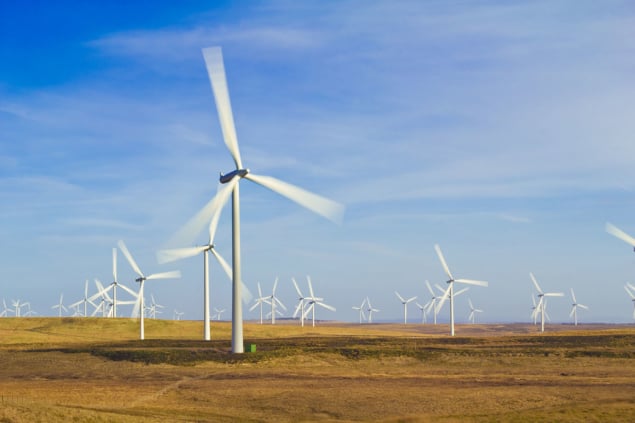
Wind energy is on the up globally with 1000 GW likely to be in place soon. Longer term, if on-land and offshore sites get congested then there is the prospect of using airborne wind-energy devices or tethered kites that operate at high altitude. Wind speed increases with height and one quite cautious study suggested that around 7.5 TW might be available globally. Others have put the total upper atmosphere resource, including jet streams, much higher at 1400 TW. Indeed, there is certainly a lot of energy up there.
However, extracting even a small part of it would be very difficult. If significant amounts of energy were somehow obtained then it could have large environmental/climate impacts, for example, on the jet stream that shapes the weather system. No one is currently proposing interventions at that level. But extracting energy from lower down in the atmosphere — perhaps up to about half a kilometre — is possible and would still offer a very large new resource — possibly four times current wind-production capacity.
Tethered to the ground
The US government have been looking at the idea of airbourne wind energy seriously as have several large companies. One early US “flying wind” design was proposed by SkyWindPower Corporation. The rotors of a drone-like system provide lift that is aided by a small aerofoil. By pulling against a ground-linked tether it generates on-board power that is then sent to the ground along the tether cable. Flying around 600 m high, the cable has to be strong enough to resist high-drag forces.
In 2014, Google invested in another airborne power generator design that was developed by US company Makani. Its 600 kW prototype — Airborne Wind Turbine (AWT) — has an aerofoil-section wing that is tethered to the ground. It flies in a large vertical circle in the stronger winds at 250-600 m altitudes, with rotors acting as both turbines and propellers, as with SkyWind. Direct-drive generators then send electricity down its tether to a ground station. The AWT can be reeled in and then reeled out again during extended periods of low wind, bad weather or for maintenance.
Makani says that, given the higher wind speeds at altitude, their AWT will deliver about twice the energy per unit of capacity than conventional turbines (i.e. its load factor would be around 60% instead of 30%). This would allow it to produce power at half the cost, and with no tower it would use 90% less material, so reducing capital costs.
There is still some way to go with these novel technologies, but if the risks to aircraft and people can be avoided, it really could be the case that the sky is no limit
A different “reel-in-and-out” tethered-kite-type approach has also been developed by the US-Indian company Skymill. This has a giant “autogyro” rotor that is tethered to the ground and operates like a yo-yo — rising and falling to rotate a winch drum on the ground that would generate power. Something similar has also been developed and tested by Kite Gen in Italy, with a large horse-shoe shaped hang glider-like kite made to swoop around in a giant circular pattern, differentially tugging on a winch-linked tether to generate power on the ground. With the (heavy) generator on the ground and less mass in the sky, this type of configuration might be more economic than the sky-borne rotor-generator systems.
Longer term, some look to large arrays of Kite Gen-type systems, as in Connaught Energy’s 32 MW concept, which offer a much better “energy returns on energy invested” (EROEI) due to the lower material requirement. Kite Gen have talked of EROEIs of maybe 100:1 and perhaps 300:1 or more, which compares to the 80:1 for the best conventional surface-wind turbines.
There will, however, be issues of secure tethering and power take-off. There will also be a need to avoid conflicts with air traffic, and crash risks. But in some remote locations — especially offshore — that may not be a problem with major energy companies like Shell and E.ON taking an interest in offshore applications. Floating the solar photovoltaic boat
Indeed, Shell has backed a UK variant developed by Kite Power Systems, in which a giant hang glider-like kite pulls on a long tether that — as with Skymill and Kite Gen — spools out from a drum on the ground which rotates to generate power. In the Kite Power version, when the kite reaches full operating altitude (perhaps 300 m or so), it is stalled and retracted to a low level with the winch system pulling it down and taking up the slack so it ready for another pass up to full altitude. A second kite, meanwhile, rises so that net power can be generated by the double-kite system continuously. Following tests in Scotland of a 500 kW system there are plans for onshore and offshore 3 MW systems.
There are also some hybrid versions. Swiss start-up Skypull has developed a multi-copter drone that can take off and land by itself, with no need for a launcher or ground wind. The take-off is battery powered, but once in the air, the battery is recharged every time the kite loops back down towards the ground, flying between 200 to 600 m high.
Niches and beyond
Flying wind may at first glance seem unlikely, but some initial sceptics have been converted and there seems to be a potential for novel ideas. Certainly, there are many promising contenders. Engineering consultants IDTechex examined the prospects for 19 of the most interesting systems and forecast the first sales of 30-100 kW systems. They even say that airborne wind energy “will be a multi-billion-dollar business in 20 years”, with scope for more beyond that.
It may be that airborne devices will initially be limited to niche applications. For example, there have been designs for dirigible balloon-type devices, which could be used on or offshore. In one variant, which looks suited for use in remote locations, a ‘doughnut’ shaped balloon has a central ducted rotor. The promise and challenges of airborne wind energy
However, some analysts are more optimistic about the wider prospect for flying systems. There certainly are some fundamental attractions. In a conventional wind turbine, most of the energy is captured by the outer tips of the blades, which move at the highest speed. The rest of the blade is less used, mostly just supporting the high-yield tip sections. That – along with the towers — add a lot of expensive mass.
By contrast, towers are not needed for flying devices and for reel-in-and-out kite systems, all the aerofoil surfaces operate at the same high speed. Although the aerofoil-mounted drone-turbine configuration has weight penalties, it has the advantage that it can fly itself into position into high-wind-speed zones. Unlike with kites, you don’t have to wait for strong ground winds for lift-off or to tow it into place.
There is still some way to go with these novel technologies, but if the risks to aircraft and people can be avoided, it really could be the case that the sky is no limit.



